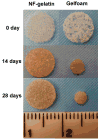Phase separation, pore structure, and properties of nanofibrous gelatin scaffolds
- PMID: 19481080
- PMCID: PMC2744837
- DOI: 10.1016/j.biomaterials.2009.04.024
Phase separation, pore structure, and properties of nanofibrous gelatin scaffolds
Abstract
The development of three-dimensional (3D) biomimetic scaffolds which provide an optimal environment for cells adhesion, proliferation and differentiation, and guide new tissue formation has been one of the major goals in tissue engineering. In this work, a processing technique has been developed to create 3D nanofibrous gelatin (NF-gelatin) scaffolds, which mimic both the physical architecture and the chemical composition of natural collagen. Gelatin matrices with nanofibrous architecture were first created by using a thermally induced phase separation (TIPS) technique. Macroporous NF-gelatin scaffolds were fabricated by combining the TIPS technique with a porogen-leaching process. The processing parameters were systematically investigated in relation to the fiber diameter, fiber length, surface area, porosity, pore size, interpore connectivity, pore wall architecture, and mechanical properties of the NF-gelatin scaffolds. The resulting NF-gelatin scaffolds possess high surface areas (>32 m(2)/g), high porosities (>96%), well-connected macropores, and nanofibrous pore wall structures. The technique advantageously controls macropore shape and size by paraffin spheres, interpore connectivity by assembly conditions (time and temperature of heat treatment), pore wall morphology by phase separation and post-treatment parameters, and mechanical properties by polymer concentration and crosslinking density. Compared to commercial gelatin foam (Gelfoam), the NF-gelatin scaffold showed much better dimensional stability in a tissue culture environment. The NF-gelatin scaffolds, therefore, are excellent scaffolds for tissue engineering.
Figures



























References
Publication types
MeSH terms
Substances
Grants and funding
LinkOut - more resources
Full Text Sources
Other Literature Sources

